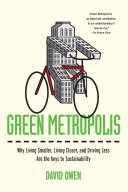
Green Metropolis
By - David Owen
Floor
-
Floor 2
Published
-
New York : Alfred A. Knopf, 2016.
ISBN 10 - 1594484848
ISBN 13 - 9781594484841
Book Status
-
1 Qnty Available with us.
Shelf No
-
1
Call Number
-
508.7471 OWE
Physical Description
-
xvi, 220 pages : color illustrations, color maps ; 22 cm
Notes
-
Includes bibliographical references and index.